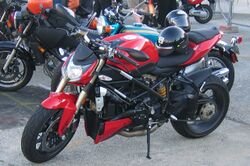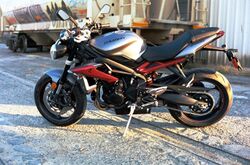Engineering:Streetfighter (motorcycle)
A streetfighter, muscle bike, or supernaked is a type of high-performance motorcycle. It is typically a large-displacement sport bike with the fairings and windscreen removed.[1][2] Beyond simply removing fairings, specific changes that exemplify the streetfighter look are a pair of large, round headlights, tall, upright handlebars such as those on a motocross bike, and short, loud, lightweight mufflers, and changes in the sprockets to increase torque and acceleration at lower speeds. Streetfighters is also the name of a UK motorcycle magazine.[3]
Later streetfighters used custom-built frames intended to overcome the weakness of the tubular steel frames of the early 4-cylinder superbikes of the 1970s and 1980s. Many of these frames turned out to be "beautifully crafted pieces of metallurgical art," perhaps only unintentionally.[4] Many were also originally racing machines.[5]
Made popular by European riders,[6] this type of custom motorcycle gained worldwide popularity, and motorcycle manufacturers responded in the late 1990s by adopting the terminology[7] and producing factory-built streetfighters, beginning with the 1994 Triumph Speed Triple[8] and the 1999 Honda X11,[9] up through the 2009 Ducati Streetfighter.
History
Though it has its styling roots in the café racer culture of the 1950s and 1960s, the streetfighter is very much inspired by the new Japanese bikes of the late 1970s and early 1980s,[10] possibly from young riders who couldn't afford to replace damaged fairings after repeated crashes. Later, more appropriate headlights were added, then high handlebars to aid in wheelies and other stunts.[11]Cite error: Closing </ref> missing for <ref> tag
The quintessential streetfghter as we know it however is arguably grown from the 1990s explosion in sportbike popularity. Due to the relative fragility of the encompassing plastic body work, and the high cost to replacement should a rider crash their bike, the owners (typically younger with limited resources) would remove the damaged fairings and fit some relatively inexpensive dirt bike signals and be on their way. Alternately crashed bikes which were otherwise completely serviceable would often be written off by insurance companies, resulting in an explosion in cheap high performance bikes on the market needing only superficial repairs to be street legal once again.[11][12] Naturally it didn't take long for manufacturers to see that there was actually a market for this growing aesthetic in the era of grunge. With a few modifications to their existing designs, which were equally cost cutting measures for manufacturers, a whole new category of motorcycle was born.
See also
References
- ↑ Wallis, Michael; Clark, Marian (2004), Hogs on 66: Best Feed and Hangouts for Road Trips on Route 66, Council Oak Books, ISBN 978-1-57178-140-6, https://books.google.com/books?id=4b_qJyw-ZX8C, "Streetfighter -- Also known as a 'hooligan' cycle, this is a sports-bike stripped of all superfluous bodywork."
- ↑ Doeden, Matt; Leonard, Joe (2007), Choppers, Lerner Publications, ISBN 978-0-8225-7288-6, https://books.google.com/books?id=7wDcbl-UsmYC&pg=PA46, "streetfighter: a type of superbike customized for maximum speed and performance."
- ↑ Streetfighters, WorldCat, ISSN 0961-9453
- ↑ Seate, Mike (2007), How to Build a Pro Streetbike, MBI Publishing Company, pp. 92–3 ff, ISBN 978-0-7603-2450-9, https://books.google.com/books?id=mqMGQPuFEFsC&pg=PA92, "[In London in the early 1990s,] I noticed an odd-looking motorcycle idling loudly across the crowded intersection. The bike's upside-down front end was topped by a pair of oversized headlights that appeared to have been stolen from a car. The rider's gloved hands clutched a set of what looked like handlebars from a motocross bike, while the exhaust can -- or what little remained of it -- was burbling like a beehive on fire.
Was this a prop from Mel Gibson's Road Warrior? Some poor motorcycle courier who had dropped his machine so many times that he'd refused to replace his damaged fairing? [more]" - ↑ Caught naked by A Cathcart - Motorcycle Sport and Leisure, 2002
- ↑ Motorcycling for Dummies - Page 69. Bill Kresnak. 2008
- ↑ Categorization bases and their influence on product category knowledge structures. JA Rosa, JF Porac - Psychology and Marketing, 2002
- ↑ Brooke, A. Lindsay (2002), Triumph motorcycles: a century of passion and power, MotorBooks/MBI Publishing Company, p. 160, ISBN 978-0-7603-0456-3, https://books.google.com/books?id=I8sIulyI7xoC&pg=PA160
- ↑ de Cet, Mirco (2002), The illustrated directory of motorcycles, MotorBooks/MBI Publishing Company, p. 214, ISBN 978-0-7603-1417-3, https://books.google.com/books?id=wNzyIcw2vxoC&pg=PA214[yes|permanent dead link|dead link}}]
- ↑ Street Bikes by R Eagen 2007
- ↑ 11.0 11.1 Inman, Gary (June 2008), "Freedom Fighter; Triumph's stripped-down sportbike came from the street", Cycle World: 36–7, ISSN 0011-4286, "The origins of the species are disputed. Some say that the Germans put high-bar conversions on sportbikes to lessen the soft tissue damage of the annual high-mileage pilgrimage to the Isle of Man for the TT races, and these were the first streetfighters. Others say -- and I agree -- that young British GSX-R riders removed their bike' fairings after crashes. They were already up to their Simpson Bandits debt to buy the bikes; they still owed three years of payments and dared not claim on the insurance for fear of having their policies loaded to the point they were priced off the road. The situation wasn't helped by the Japanese firms' replacement-parts pricing structure making new bodywork out of the question. And the old oil-cooled Gixxer Four is just about the best looking Japanese motorcycle ever, so why not show it off?"
- ↑ Cite error: Invalid
<ref>tag; no text was provided for refs namedSeate 2007 95
External links
 |



